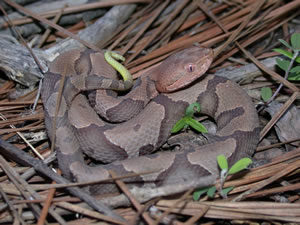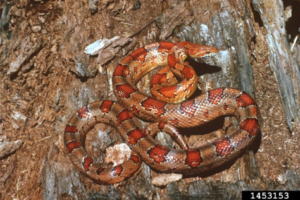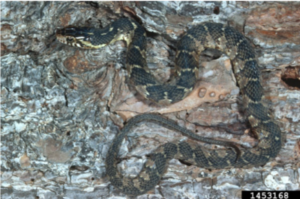The fear of being bitten by a snake worries many folks whether the snake is venomous or not. There are 38 species of snakes found in South Carolina, but only 6 are venomous. The venomous snakes found in South Carolina are all pit vipers with one exception – the coral snake. The pit vipers include copperhead, cottonmouth, pigmy rattlesnake, eastern diamondback rattlesnake, and timber rattlesnake. Pit vipers get their name from having a heat-sensing pit located between their eyes and their nostrils which helps these snakes locate their warm-blooded prey.
Every year, I receive a plethora of phone calls and emails asking me 1) to identify whether a snake is a copperhead and 2) what should I do with it. Many of these phone calls and emails result in the suspect snake being a similar-looking, non-venomous snake with characteristics that are hard to distinguish from the copperhead. The two most common non-venomous snake species mistaken for the copperhead are the corn snake and the northern water snake.
Ways to Identify a Copperhead
There are several ways to differentiate the copperhead from these two similar-looking species, but first, let’s start with a description of the copperhead.
Head
The copperhead gets its name from the coppery-tan color found mainly on its head and throughout parts of its body down to the tail. An adult copperhead’s average length ranges between 2 to 3 feet but can reach 4 feet.
Since the copperhead is a pit viper, you’ll notice a very distinctive triangular-shaped head. Some people call it an “arrowhead-shaped” head. These wider parts of the head allow for space to fit the snake’s fangs and venom glands.

Pattern and Camouflage
Parts of the pattern of the copperhead resemble an hourglass and is one of the most diagnostic traits of all. The hourglass shape lays somewhat “sideways” on the copperhead’s back; the wider portion of the shape starts on one side of the body, thins towards the middle-top edge of the back (closest to the spine), and then widens back out to the opposite side of the snake. To put it simply, the top of the hourglass touches the left side of the body, the bottom of the hourglass touches the right side of the body. Keep in mind that the hourglass shapes can occasionally “mismatch” and seem like they disconnect from the complete shape, especially towards the tail.
Copperheads are not aggressive, nor do they go out of their way to bite humans or other unsuspecting bystanders. It all comes down to their camouflage. When curled up, their camouflage resembles a pile of fallen leaves; this helps them remain hidden from potential predators – including you. A copperhead bite typically occurs when it’s least expected, after several attempts to discourage you, the “predator” from coming close. When walking through potential copperhead habitat, the snake will likely spot you first and may try to move away. As you get closer, it will curl up into its camouflage pile, blending in with fallen leaf litter on the ground. As you get closer, the copperhead will start to shake, or “rattle,” its tail to resemble a rattlesnake. Get even closer, and the copperhead will lift its head to show you it’s ready to bite if you keep provoking. The last and final step is a strike. Even though you may have never noticed any of the prior warnings, all the snake knows is that he gave you all warnings to stay away and that you still persisted. The bite is the last resort to defend itself from an animal much larger than itself and which it certainly doesn’t see as a potential meal.
Eyes
Eye pupil shape is a very easy way of identifying not only copperheads but also most venomous snakes in South Carolina, except for the coral snake. The copperhead has a yellow eye with a black vertical and elliptical pupil, similar to that of a cat’s eye. Please be advised that this does require great eyesight and an excellent viewpoint. However, don’t try to get too close to the snake to see this feature, as you might put yourself in danger and ultimately provoke a strike from the snake. The venomous coral snake and all other nonvenomous South Carolina snakes have round pupils.

Photo Credit: J.D. Wilson, University of Georgia, Savannah River Ecology Lab, srelherp.uga.edu
Juvenile Yellow Tails
Juvenile copperheads are known for having a bright yellow tail that they use to lure their prey, such as frogs and small lizards.
Ways to Differentiate Similar Species from Copperheads

Photo Credit: Sturgis McKeever, Georgia Southern University, Bugwood.org
Corn Snake
The corn snake is one of several North American species of rat snake. Unlike copperheads, corn snakes do not have fangs but catch and subdue their prey by constriction (squeezing and suffocating).
Corn snakes are more colorful than copperheads – they have several color variants but are typically redder in color as opposed to the copperhead’s copper-tan complexion.
While copperheads have most of their hourglass shape on the sides of their body, corn snakes will have most of their thick “blotch” markings on the tops (or their back) of their body. Corn snakes also have a distinctive black-and-white “checkerboard” pattern on their bellies.
Corn snakes have a smaller, narrower head that aligns with their slender body angle and size, different from the copperhead’s triangular head and thicker body width. It’s also important to note the corn snake’s round pupil that is a common characteristic of our nonvenomous snakes.

blotches that are narrow on the sides and wider
towards the backbone. Photo Credit: Sturgis McKeever, Georgia Southern University, Bugwood.org
Northern Water Snake
The northern water snake is a large, nonvenomous common snake native to North America. This, in my experience, is the snake most commonly mistaken for the copperhead. This is most likely because of their similar pattern and colors.
The pattern of the northern water snake is dark blotches that are narrow on the sides and wider towards the backbone. This differs from the copperhead’s pattern that is wider on the sides and narrower towards the backbone. Unlike copperheads, northern water snakes have round pupils, which as stated previously, is a common characteristic of nonvenomous snakes. The northern water snake also has a narrower head compared to the copperhead’s “arrow-shaped” head since it lacks venom glands and fangs.
Final Comments Regarding Snakes
All snakes, venomous and nonvenomous, play a very important role in South Carolina’s environmental ecosystems. Also, from a human perspective, they play a large role in controlling rodents and many other small-sized nuisance wildlife populations. This helps to decrease damage to property and the spread of disease.
The main function of fangs and venom glands in venomous snakes are for obtaining food, and they are used for defense only as a last resort. To best protect yourself against snake bites, always be aware and alert while in the woods, your backyard, or other outdoor situations.
If you are in any way uncertain whether a snake is venomous or not, always exercise precaution and do not attempt to approach or catch it. When left alone, they normally move on once they believe the threat has left. Most people are bitten or injured when either harassing or trying to approach a venomous snake too closely. In the unlikely case you are bitten by a venomous snake, it is best not to try and treat the bite yourself. The victim must stay calm and seek medical attention as soon as possible.
Snakes of any type often evoke fear, to a large degree, because they are poorly understood by the general public. Respect snakes from afar if you prefer, and you should not run into any issues that are unpreventable.
This article was originally featured in the Fall 2020 Version of CU in The Woods newsletter.
Author(s)
Parker Johnson, Cooperative Extension, Forestry and Wildlife Agent
This information is supplied with the understanding that no discrimination is intended and no endorsement of brand names or registered trademarks by the Clemson University Cooperative Extension Service is implied, nor is any discrimination intended by the exclusion of products or manufacturers not named. All recommendations are for South Carolina conditions and may not apply to other areas.
Clemson University Cooperative Extension Service offers its programs to people of all ages, regardless of race, color, gender, religion, national origin, disability, political beliefs, sexual orientation, gender identity, marital or family status and is an equal opportunity employer.
